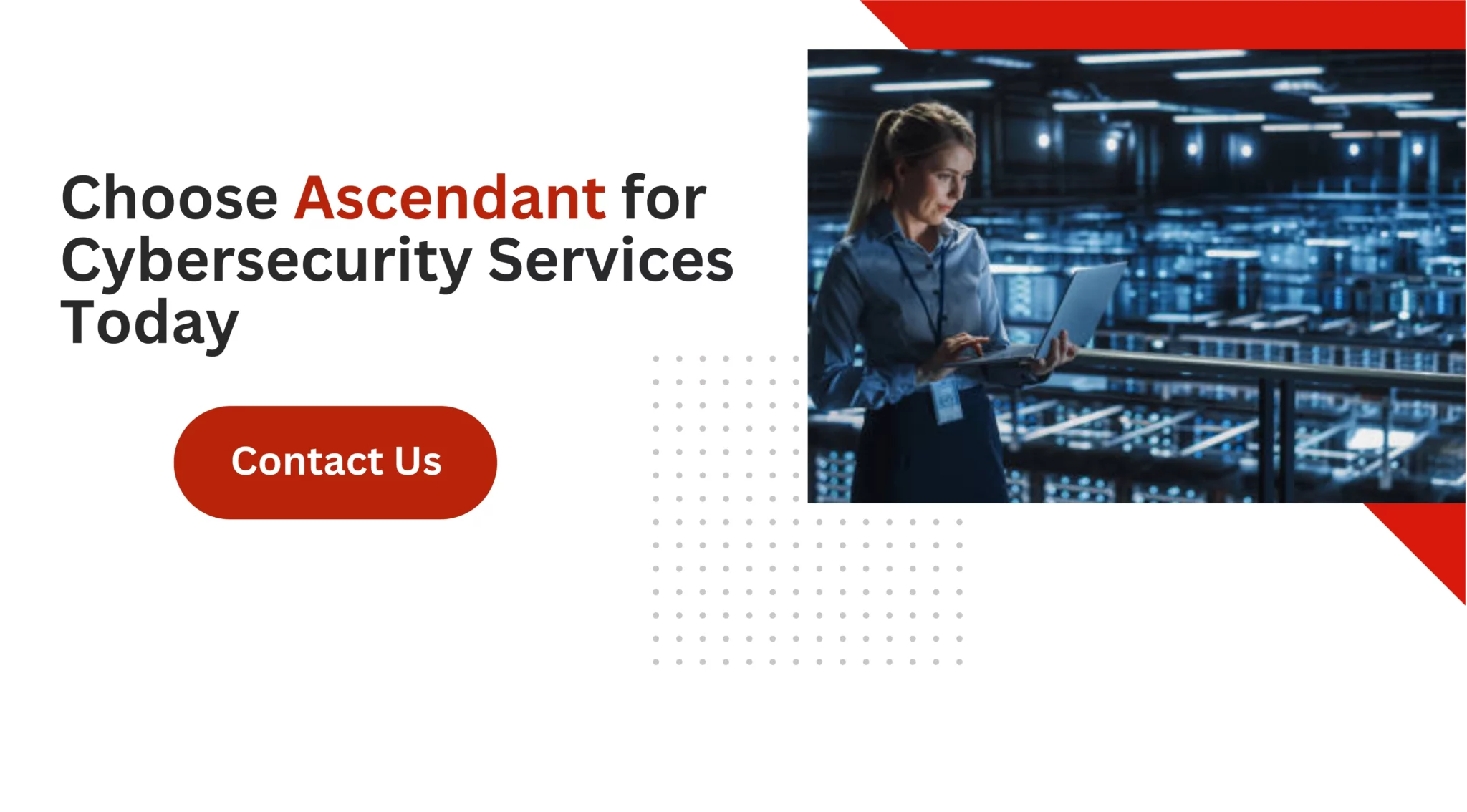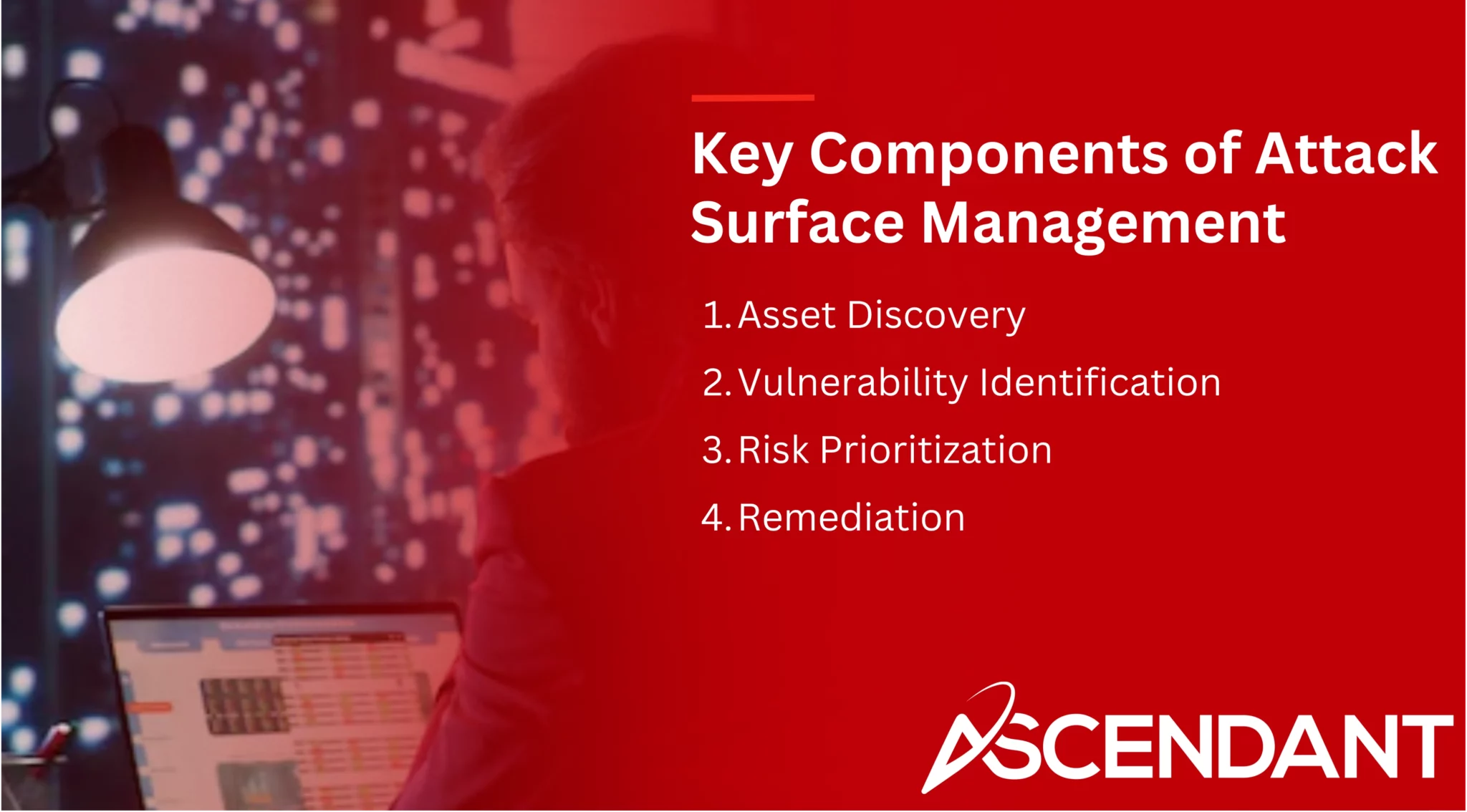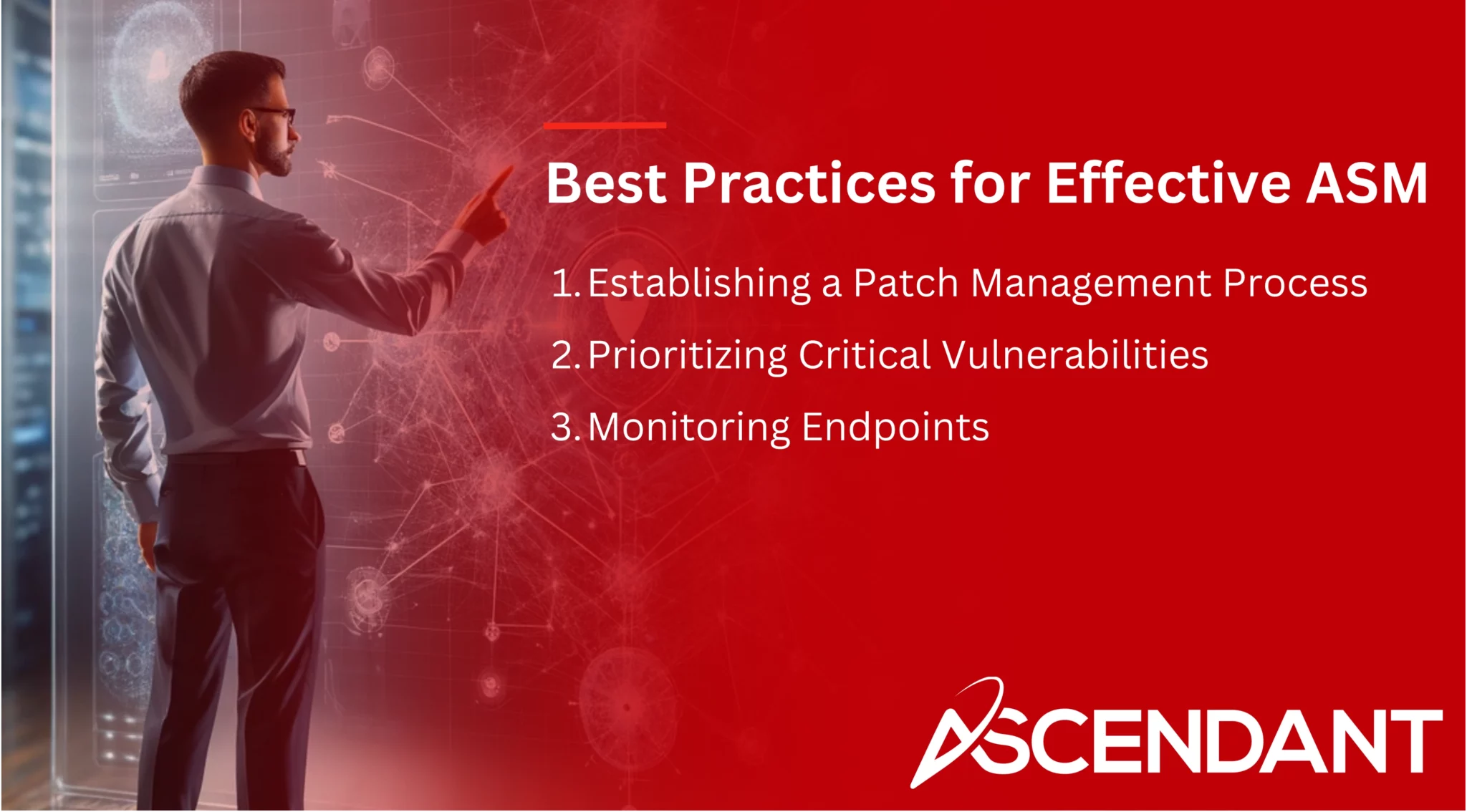Attack surface management (ASM) is the process of identifying and managing risks across an organization’s digital assets. This involves asset discovery, vulnerability identification, and continuous monitoring. In this article, we’ll explore effective ASM strategies, key components, and best practices to help you enhance your organization’s security.
Key Takeaways
- Attack Surface Management (ASM) is essential for identifying and reducing vulnerabilities within an organization’s digital ecosystem, requiring continuous monitoring and assessment to enhance security posture.
- Key components of effective ASM include asset discovery, vulnerability identification, risk prioritization, and remediation, all of which work together to mitigate risks across digital assets.
- The impact of digital transformation, especially through cloud adoption and remote work, has expanded attack surfaces, necessitating a proactive ASM strategy that incorporates continuous monitoring and threat intelligence to address emerging vulnerabilities.
Understanding Attack Surface Management
The practice of Attack Surface Management (ASM) is directed at recognizing and mitigating potential vulnerabilities across an organization’s entire digital footprint, with the goal of diminishing overall risk. ASM’s importance stems from its effectiveness in defending against risks associated with unidentified or neglected vulnerabilities, which are prime targets for attackers. By persistently evaluating and addressing known weaknesses, businesses can fortify their security posture and protect essential resources.
To implement a robust ASM strategy effectively, it is crucial to possess an intricate comprehension of the organizational context that enables prioritization of security remediations correlating to high-risk threats with significant impact. This process necessitates perpetual monitoring and testing due to both the expansionary nature of attack surfaces and newly surfacing cybersecurity hazards. The tendency for assailants to exploit lesser-known or seemingly inconsequential paths stresses the necessity for exhaustive visibility over such routes.
Incorporation into a holistic cyber defense plan makes managing an entity’s attack surface indispensable. Ongoing identification processes paired with vulnerability evaluations—highlighting misconfigurations or unwarranted exposure—are key components within ASM tactics. Looking through an adversary’s lens aids in detecting elaborate dangers potentially missed by conventional safety protocols, thereby reinforcing an enterprise’s overarching security posture significantly.
Key Components of Attack Surface Management
Attack surface management encompasses several essential functions, which are:
- The identification of assets
- The detection of vulnerabilities
- The ranking of risks based on their priority
- The implementation of corrective measures
Combined, these elements form an integrated strategy to safeguard and manage the array of digital assets within a company against potential threats.
Each function is instrumental in pinpointing possible attack vectors while also guaranteeing that security practices are effectively ranked by importance and executed accordingly.
Asset Discovery
In the realm of Attack Surface Management, asset discovery is crucial for pinpointing every system, application, and possible point of entry within a network’s infrastructure. This encompasses not just assets that are already on the radar, but also those that may be hidden or overlooked—including unknown entities and third-party connections. The deployment of automated instruments plays an essential role in refining both the detection of recognized assets and unearthing those yet to be identified, leading to a holistic approach towards managing all organizational resources.
Maintaining an up-to-date inventory list is indispensable for operative ASM as it aids quick spotting and rectification of security flaws. Associating discovered assets with their respective business divisions enhances incident handling capabilities as well as operational productivity when undergoing asset discovery. Keeping track of all corporate holdings allows businesses to effectively oversee their attack surface while simultaneously lowering associated dangers.
Vulnerability Identification
Continuously analyzing the attack surface and scanning for vulnerabilities are crucial measures to detect emerging threats. By leveraging threat intelligence feeds, analysis tools can pinpoint existing weaknesses and utilize vulnerability databases for their evaluations. Nevertheless, scans that only focus on recognized assets could overlook unknown ones, which represent a significant risk to security infrastructure. A combined approach of manual examination with automated processes is advisable for thorough detection of vulnerabilities.
In the process of identifying susceptibilities, elements like outdated applications, configuration errors, and unprotected ports are investigated. The integration of threat intelligence into this procedure provides organizations with customized insights about potential weak spots in their unique settings.
Given the uptick in remote work leading to greater use of personal devices within corporate networks. It’s imperative that companies maintain constant vigilance by monitoring vulnerabilities across every part of their attack surface without lapse.
Risk Prioritization
The primary objective of prioritization within Attack Surface Management is to pinpoint and remediate the vulnerabilities with the highest potential impact on an organization. To determine which vulnerabilities, require immediate attention, factors such as how critical an asset is, its exposure risk, and whether there are active exploits against it should be considered. By strategically focusing efforts on these areas of concern, companies can direct their resources toward rectifying the most severe weaknesses in their security posture.
By integrating cyber threat intelligence into ASM processes, security teams gain valuable insights that aid them in spotting and elevating the urgency for internet-facing assets that are exceedingly susceptible to attacks. If monitoring activities concentrate on less significant aspects of attack surface management instead of pressing threats or vulnerable points, it could result in wasted effort and overlooked dangers. Properly setting priorities for surveillance tasks ensures that vital assets receive more attention from cybersecurity measures thereby enabling organizations to allocate their defensive resources wisely.
Remediation
An attack surface management solution aims to either diminish or completely negate the potential for cyberattacks and data breaches. This remediation effort commences with a thorough mapping of the attack surface, followed by ranking the identified risks in order of importance. Subsequent to risk prioritization, steps such as applying patches, configuring firewalls properly, and limiting permissions are taken to resolve these issues so as to mitigate the chances of an assault on one’s cyber environment.
It is crucial that remediation be approached as a constant cycle in response to emerging vulnerabilities and security threats. The practice of persistent monitoring ensures that new weaknesses can be discovered quickly and addressed before they are exploited.
Incorporating threat intelligence into this process bolsters our ability to detect weak spots promptly, which greatly enhances an organization’s strategy in mitigating risks associated with their digital presence effectively.
Types of Attack Surfaces
An effective Attack Surface Management strategy incorporates both external attack surface management and internal perspectives on an organization’s cyber assets. Attack surfaces can be categorized into three main types: digital, physical, and social engineering. Additionally, attack surfaces can be classified into known, unknown, rogue, and vendor assets, each posing unique challenges and risks.
These categories are essential for comprehensive security management.
Known Assets
Assets that are part of the attack surface management, such as authorized devices, systems, and applications, are acknowledged by the organization. These assets usually have thorough documentation and surveillance which facilitates their management and security.
Despite this, it remains imperative to consistently monitor these known assets in order to maintain their currency with updates and fortify them against emerging vulnerabilities.
Unknown Assets
Unsanctioned and unrecognized, unknown assets consist of devices and software outside the organization’s purview, extending to both known and unknown elements. Typical forms of these covert assets include:
- External websites managed by third parties
- Workloads hosted on cloud platforms
- Devices connected through the Internet of Things (IoT)
- Unused network addresses that have fallen into neglect
The concept of Shadow IT encapsulates those unapproved applications or cloud services within an enterprise not subjected to formal vetting or security measures. Such invisible components can jeopardize cybersecurity by introducing vulnerabilities.
The sprawling nature of today’s attack surface often leads organizations to lose track of their full digital footprint due in part to such unseen IT resources. Leveraging tools dedicated to asset discovery alongside ongoing surveillance is key in spotting these elusive assets, thereby preempting potential threats they might pose.
By effectively identifying and managing unidentified assets, companies bolster their overall security posture against cyber incursions significantly minimizing exposure points attackers could exploit.
Rogue Assets
Unauthorized assets, known as rogue assets, represent a potential security risk. These are typically unapproved devices that connect to an organization’s network, complicating management and securing efforts. The proliferation of shadow IT exacerbates the challenge of gaining full insight into all assets and vulnerabilities present within the network.
IoT devices lacking adequate security can serve as entry points for more extensive network intrusions and exemplify such rogue assets. To manage these effectively and shield against network weaknesses, constant surveillance of the environment combined with stringent security protocols is necessary.
By taking steps to confront rogue assets directly, organizations can diminish the risks associated with them thereby strengthening their overall security posture.
Importance of Continuous Monitoring
To preserve an accurate perception of potential security vulnerabilities, it is critical to engage in continuous monitoring. An effective Advanced Security Management (ASM) strategy requires the prioritization of constant vigilance to adjust swiftly to emerging threats and maintain secure conditions amid alterations.
Organizations must commit to frequent vulnerability scans and ongoing evaluations of their security posture. This approach enables them to identify and counteract developing threats efficiently.
Real-Time Visibility
It’s imperative to have immediate insight into an organization’s digital presence in order to recognize potential hazards linked with its attack surface. Continuously observing digital assets allows for the tracking of expansion and quick mitigation of emerging vulnerabilities. Conducting consistent evaluations and monitoring can reveal early indications of advanced persistent threats, thereby diminishing the likelihood of major security violations.
Managing assets efficiently means keeping tabs on recognized assets via established security procedures, which aids in enhancing overall visibility. To curtail possible attack vectors within a company, endpoint transparency is crucial since these points often serve as gateways for cyber assailants.
Employing unified monitoring solutions augments an organization’s ability to effectively oversee its digital footprint, enabling better management against diverse attack vectors.
Speeding Up Remediation
Security teams are empowered by attack surface monitoring solutions, which provide immediate notifications and critical insights for required corrective measures. The practice of incessant monitoring is pivotal in overseeing vulnerabilities as it delivers ongoing transparency regarding an organization’s potential points of exposure. This constant vigilance aids security professionals in the effective ranking and resolution of weaknesses, promoting swift action against looming threats.
By accelerating vulnerability remediation through continuous observation, organizations can notably bolster their defenses against cyber-related adversities. Real-time updates coupled with sharp insights furnish security personnel with enhanced capabilities to manage risks adeptly, thereby diminishing the chances of falling victim to cyberattacks and data breaches.
Leveraging Threat Intelligence in ASM
Incorporating threat intelligence into Attack Surface Management (ASM) yields strategic benefits by offering insights into digital risks and relevant contextual details. Knowledge of particular vulnerabilities and threats aimed at the organization serves to augment the outcomes derived from an attack surface assessment.
Such a combination is instrumental in enabling organizations to pinpoint and neutralize complex cyber threats, thereby substantially strengthening their security posture.
Identifying Emerging Threats
Leveraging threat intelligence can enhance an organization’s capability to preemptively identify emerging threats and new attack vectors. This type of intelligence sheds light on the latest trends in cyber-attack methods, equipping organizations with the foresight needed to anticipate and counteract potential risks.
Incorporating threat intelligence allows for early detection of evolving cyber threats, enabling adjustments to defensive measures as required. Such a proactive stance empowers security teams by keeping them one step ahead of key threat actors, ensuring that their protective strategies remain current and effective.
Enhancing Security Posture
Integrating threat intelligence into security protocols enhances an organization’s ability to take a proactive stance in bolstering its security posture. By managing threat intelligence effectively, organizations can fortify their defenses preemptively against cyber attacks and are well-equipped to address emerging threats as well as mitigate risks efficiently.
Challenges in Attack Surface Management
The contemporary attack surface is in constant flux, unique to each entity, enduring, and on an expansion trajectory. The intricate task of overseeing such attack surfaces intensifies as organizations embrace digital transformation and incorporate cutting-edge technologies. A major difficulty that institutions encounter is the struggle to maintain clear visibility while efficiently managing their modern attack surface.
Simultaneously, there exists a notable deficit in qualified personnel adept at administering and surveilling these multifaceted settings, which complicates the effort to uphold robust cyber defenses.
Managing Complexity
Assets that are not accounted for can create vulnerabilities since they evade the organization’s security protocols. These unmanaged assets, including rogue devices connecting to the network without approval, pose risks due to a lack of adherence to established security practices and policies. As organizations encounter an expanding array of asset types and volumes, these new elements bring forth additional susceptibilities and add complexity to maintaining secure environments.
As third-party integrations become more prevalent within systems, they amplify the challenge of overseeing attack surfaces effectively. Implementing strong strategies is imperative for recognizing and navigating through this intricate terrain so that every asset is both acknowledged and safeguarded appropriately.
Maintaining Visibility
The practice of remote work can obscure the oversight of devices that access company networks, as domestic network security typically falls short of what is maintained in corporate settings, thereby heightening susceptibility to threats.
By achieving visibility across multicloud environments, security teams are empowered to address essential inquiries about vulnerabilities within hybrid and multicloud infrastructures. This ensures comprehensive identification and proficient handling of all possible risks.
Adapting to Evolving Threats
Continuous adaptation and mitigation measures are imperative in response to emerging vulnerabilities and shifting threat environments. Prioritizing the remediation of the most critical vulnerabilities is crucial for improving an organization’s security posture. The assessment of such vulnerabilities should consider their severity, likelihood of exploitation, and importance of the compromised asset.
Due to insufficient security implementations, many IoT devices become susceptible to cyber risks. Vulnerabilities that are prevalent with remote work scenarios include outdated home routers that lack current patches for known security issues as well as mobile devices vulnerable without adequate protection.
To counteract evolving threats effectively, organizations must ensure that their security teams remain alert and constantly refine their strategies for securing assets against potential compromises.
Best Practices for Effective ASM
Prioritizing remediation efforts for vulnerabilities based on business impact is crucial for effective ASM. Organizations should focus on high-impact issues that are most likely to be exploited based on industry trends and the likelihood of exploitation.
Incorporating key practices into the chosen ASM solution is essential for effective attack surface monitoring and management.
Establishing a Patch Management Process
Creating a procedure for patching vulnerabilities is essential to perpetually identify and amend network weaknesses. By conducting routine examinations, an organized approach to patch management ensures that no vulnerability goes unnoticed or unattended. Taking preventive action against these security gaps significantly diminishes the risk of cyberattacks and data breaches.
Employing practical threat intelligence empowers organizations to fortify their defenses ahead of potential exploitation by attackers. The integration of leading-edge features like sophisticated analytics and artificial intelligence-driven insights within premier ASM tools bolsters security protocols, contributing effectively towards patch management enhancements.
Prioritizing Critical Vulnerabilities
Concentrating on the most critical vulnerabilities enables organizations to utilize their resources with maximum effectiveness and guarantees robust security measures by targeting high-impact vulnerabilities.
Monitoring Endpoints
Incorporating endpoints into the management of an attack surface is critical since they frequently become prime targets for cyber threats. Often neglected by organizations, endpoints represent a key part of the attack surface that demands attention. Vigilant and ongoing monitoring of these endpoints is essential to detect and remediate vulnerabilities swiftly, thereby diminishing the likelihood of security infractions.
Employing threat intelligence significantly bolsters a more knowledgeable approach towards security, facilitating quick reactions to weaknesses and strengthening defense strategies as a whole. Diligent endpoint surveillance fortifies an organization’s security posture against possible attack vectors, safeguarding it from potential breaches introduced by various attack vectors.
Impact of Digital Transformation on Attack Surfaces
Adopting cloud services, integrating Internet of Things (IoT) devices, and supporting remote workers all contribute to the widening of an organization’s attack surface. This growth is a considerable factor in the evolving dynamics of attack surfaces.
As these technologies are implemented, they bring with them specific weaknesses that constantly shift the nature of potential threats. Such changes present ongoing challenges to established security measures within organizations.
Cloud Adoption Risks
Security teams face significant challenges when dealing with cloud-based operations, which include the complexities of monitoring attack surfaces and handling vulnerabilities effectively. If not properly managed, cloud assets can become severe cybersecurity threats leading to data breaches and the compromise of confidential information. The distinct vulnerabilities brought forth by different cloud service models present unique security obstacles that necessitate immediate attention.
Attackers may exploit insecure API connections as a means to gain unauthorized access in cloud environments, thereby adding another layer of complexity for security efforts. To minimize these risks, it is critical to implement strong security protocols along with persistent surveillance over all cloud assets.
IoT Device Vulnerabilities
Poorly configured IoT devices may be susceptible to compromise, presenting a growing concern for many entities that rely on them. These devices are increasingly essential but come with inherent weaknesses requiring vigilant management. Should these vulnerabilities be exploited, it could result in illicit entry into systems, loss or theft of data, and an enlargement of the attack surface threatening the organization’s security.
Implementing strong Attack Surface Management (ASM) tactics is critical and should encompass targeted actions to secure vulnerabilities associated with IoT devices. Organizations can strengthen their overall security posture by proactively mitigating such risks pertaining to IoT technology thereby safeguarding themselves from emerging threats.
Remote Work Challenges
The proliferation of remote work has markedly increased the attack surface for organizations. As employees connect to corporate networks using personal devices or public Wi-Fi, these potentially insecure points of access broaden the attack surface. Networks at home typically offer less security than those within a company’s infrastructure, amplifying potential vulnerabilities and putting pressure on current security protocols.
It is critical that companies stay alert and adopt comprehensive security approaches to counteract the risks associated with remote working arrangements. To identify and mitigate vulnerabilities effectively in environments where staff are working remotely, it is necessary for an organization to engage in ongoing surveillance alongside periodic evaluations.
Evaluating ASM Solutions
It is crucial to assess ASM solutions carefully to ensure they align with an organization’s unique requirements and circumstances. The GigaOm Radar for Attack Surface Management offers a comprehensive guide on the various ASM solutions at hand, aiding organizations in navigating their choices and making knowledgeable selections.
Embedding essential practices into the ASM solution boosts its overall efficacy and contributes to a robust security approach, encompassing the core functions of attack surface management.
Criteria for Selection
To effectively manage an expanding collection of digital assets without diminishing performance, ASM solutions must be scalable. The ability to integrate smoothly with current security tools and workflows is imperative for the functionality of ASM solutions. Simplicity in operation is a crucial attribute to look for in ASM tools so that they can be efficiently wielded by security teams without requiring significant training.
When choosing ASM solutions, enterprises should evaluate these factors carefully to guarantee they possess the appropriate instruments to proficiently oversee and protect their attack surfaces. By selecting an optimal ASM solution, organizations are better positioned to strengthen their security posture and reduce potential risks.
Top ASM Tools
The GigaOm Radar for Attack Surface Management provides a thorough analysis of ASM solutions in the current market. It features an overview of top-tier ASM vendors, detailing each one’s capabilities, to aid organizations in making well-informed choices. By evaluating the various strengths and weaknesses of these tools, companies are equipped to identify the most suitable options that align with their specific requirements.
Making astute decisions is vital when it comes to picking appropriate ASM tools guided by insights from GigaOm Radar. The selection process is integral for bolstering security protocols and managing attack surfaces with efficacy.
Summary
To summarize, proficient management of attack surfaces necessitates an all-encompassing strategy that encompasses the discovery of assets, identification of vulnerabilities, prioritization of risks, and their remediation. The persistent monitoring combined with the assimilation of threat intelligence is crucial for preserving a current security posture and adjusting to changing cyber threats. Through thorough understanding and control over their attack surfaces, organizations can strengthen their defenses against complex cyber-attacks. Adopting industry best practices along with choosing suitable Attack Surface Management (ASM) solutions are fundamental in devising a solid security framework capable of mitigating risks and shielding vital resources.
 Frequently Asked Questions
Frequently Asked Questions
What is Attack Surface Management (ASM)?
Attack Surface Management (ASM) involves identifying, prioritizing, and mitigating vulnerabilities within an organization’s digital ecosystem to reduce overall risk.
It is essential for organizations to proactively manage these vulnerabilities for enhanced security.
Why is continuous monitoring important in ASM?
In Application Security Management (ASM), the practice of continuous monitoring is essential because it enables organizations to stay updated on new security vulnerabilities and quickly react to changing threats, thus ensuring their systems are protected effectively.
Adopting this forward-thinking strategy guarantees that potential dangers are continuously identified and addressed.
How does threat intelligence enhance ASM?
Incorporating threat intelligence into Attack Surface Management (ASM) markedly increases its capability to pinpoint and address sophisticated cyber threats. This integration offers detailed information on particular vulnerabilities, enabling a more focused effort in identifying and neutralizing potential risks.
Adopting this methodical approach serves to bolster the overall security posture significantly by enriching ASM with actionable insights regarding emerging or existing threats.
What are the key components of ASM?
The key components of ASM are Asset Discovery, Vulnerability Identification, Risk Prioritization, and Remediation, all essential for effectively managing and mitigating risks within an organization’s digital landscape.
Each component contributes to a comprehensive risk management strategy.
How does digital transformation impact attack surfaces?
Incorporating cloud technologies, IoT devices, and enabling remote work as part of digital transformation significantly expands an organization’s attack surface. This expansion introduces new vulnerabilities and alters the existing threat landscape.
Consequently, there is a critical need to reassess current security protocols in order to adequately tackle these emerging challenges and protect the enlarged attack surface of organizations.



